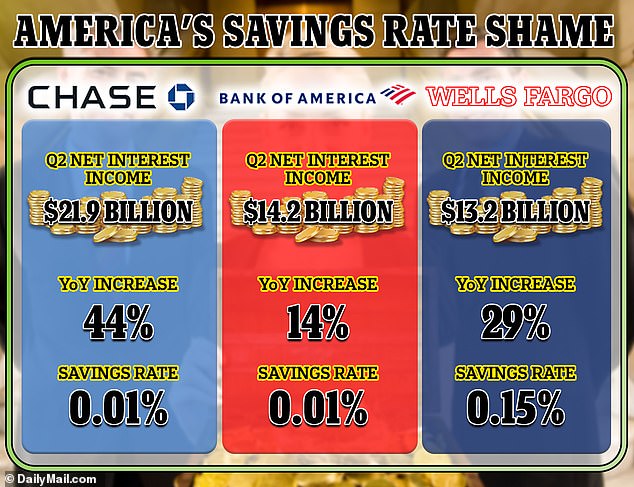Americans Are Being ‘Scammed’ By Big Banks, Robinhood CEO Says – As Savings Rates Won’t Rise Above 0.6% Even as Borrowing Costs Hit Record Highs
- Vlad Tenev argued that it is part of the ‘playbook’ of traditional banks not to pass on the revenue from higher interest rates to customers
- Despite the highest interest rates in 22 years, the average American savings account yields less than 0.6 percent
- JPMorgan Chase and Bank of America offer a 0.01 percent return on their standard savings accounts
Americans are being ‘scammed’ by big banks, according to Robinhood CEO Vlad Tenev.
The stock trading app made famous by the GameStop craze will now pay subscription members a 5 percent annual return on uninvested money – to rival traditional banks that offer paltry returns of just 0.01 percent.
“Customers are starting to wake up and realize that they have been scammed by these traditional financial institutions,” Tenev said. CNN.
“These banks are actually generating all this revenue that they’re not sharing with customers. We see an opportunity to correct that.’
Even though the Federal Reserve’s aggressive rate hike campaign has pushed borrowing costs to their highest level in 22 years, the average U.S. savings account is yielding less than 0.6 percent, a study by Bank rate.
Americans are being ‘scammed’ by big banks, according to Robinhood CEO Vlad Tenev
Tenev argued that it is part of traditional banks’ “playbook” not to pass on the revenue from higher interest rates to customers.
“It’s a bit like banks assumed that customers aren’t smart or intelligent enough to realize that interest rates are changing, and that they could generate higher risk-free returns on their funds backed by the U.S. government,” Tenev said.
In response, the American Bankers Association said recent surveys showed many customers are satisfied with their banks.
“Banks of all sizes have a reputation for providing reliability, security and convenience, as well as competitive pricing,” spokesman Jeff Sigmund told CNN.
“It’s also worth noting that Robinhood can only offer FDIC protection on some of its products because it works with FDIC-insured banks.”
The Federal Deposit Insurance Corporation (FDIC) is a government corporation that provides deposit insurance to depositors at U.S. commercial banks and thrifts.
A DailyMail.com analysis earlier this year found that JPMorgan Chase, Wells Fargo and Bank of America raked in nearly $50 billion from higher interest payments in the second quarter of this year – but none of them raised interest rates on their savings accounts.
JPMorgan Chase and Bank of America offer a paltry 0.01 percent interest rate on their standard savings accounts, while Wells Fargo offers a slightly better 0.15 percent.
By comparison, a host of tech companies like Apple and Walmart-backed One have entered the savings space, offering competitive yields of 4.15 percent and 5 percent, respectively.
It means that a saver with an Apple account, for example, can earn 400 times more interest than a Bank of America customer.

Three of America’s largest banks raked in nearly $50 billion from higher interest payments in the second quarter of this year – but none increased interest rates on their savings accounts, a Ny Breaking.com analysis shows.
The 5 percent Robinhood fee applies to new and existing customers of Robinhood Gold, a subscription service that costs $5 per month.
The company said its premium customers’ money will be automatically transferred to deposit accounts at a network of FDIC-covered banks.
Customers who don’t sign up for Robinhood Gold receive a more modest 1.5 percent return on uninvested money.
It’s the latest in a broader strategy by the company to become more than just a stock and cryptocurrency retail store.
The company offers traditional and Roth retirement accounts and also acquired a credit card startup earlier this year.
“Robinhood is transforming into a full-service financial institution,” Tenev told CNN, noting that more than half of the company’s revenue is now generated by net interest income.
“There are trillions of assets in savings accounts that are ours for the taking.”
The company may also be looking to grow its user numbers and boost its stock price, which has fallen well below its 2021 IPO price.
Since going public in July 2021 at $38 per share, the stock price has fallen to just $8.
